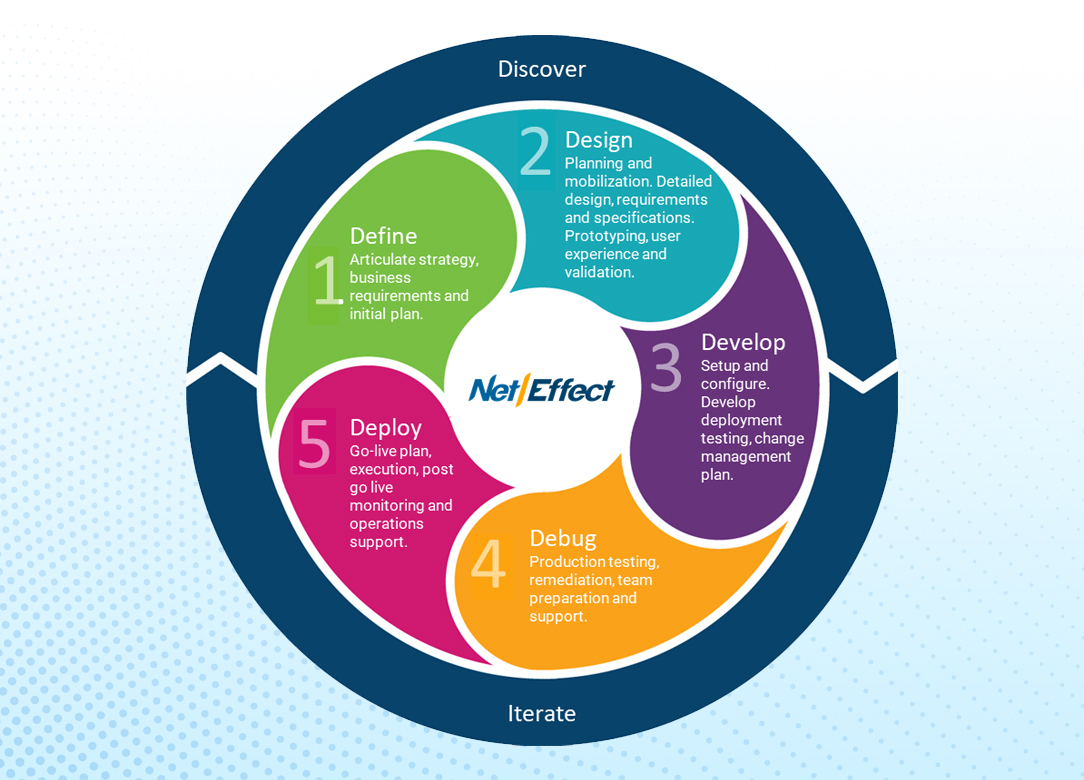Digital Transformation (DT) is simply how business works now. It’s not an optional project; you have to constantly evolve digitally to stay competitive and relevant. For large enterprises, though, this process is tough. It’s expensive, complicated and inherently risky.
Why do so many digital initiatives stall or fail to pay off?
It’s usually not the technology itself. It’s a complete breakdown in the process; the vital connection between what the business needs and what the engineering teams actually build. This disconnects leads to budget overruns, projects getting bigger than planned (scope creep) and new tools that users ultimately reject.
NetEffect fixes this chaos. We use a proven, structured, five-phase framework to keep things simple and predictable: The 5Ds for Successful Digital Transformation: Define, Design, Develop, Debug and Deploy.
This systematic approach gives large organizations the clarity needed for deep, reliable change. By strictly following the 5Ds, every single decision serves a clear business purpose. We become your dedicated digital transformation partner, ensuring your investment delivers real results.
The NetEffect Approach: Unifying Strategy and Execution
Achieving large-scale transformation takes more than just smart, specialized teams; it requires them to work together flawlessly.
NetEffect’s service portfolio is intentionally designed to support the full 5D lifecycle. We eliminate organizational silos by integrating key service domains into a single, cohesive delivery model:
- Strategy and Program Management: We set the high-level mission, create detailed roadmaps and establish clear project governance.
- Web Development and Design: We focus on human-centered design, superb user experience (UX) and accessible front-end solutions.
- Engineering and Software Development: We build robust, secure and scalable cloud applications.
- Managed IT Services: We guarantee continuous stability, perform rigorous testing and provide 24/7 post-launch support.
The 5D methodology is the predictable flow that mobilizes these four capabilities, ensuring a smooth transition from abstract planning to measurable market success.
The 5D Framework at a Glance
This table summarizes how each phase of the NetEffect methodology builds upon the last, focusing on clear deliverables and risk mitigation.
| Phase | Core Goal | Primary Risk Mitigated | Key Outcome/Deliverable |
| DEFINE | Establish the measurable ‘Why’ and ‘What.’ | Scope Creep and Lack of Accountability. | Business Requirements Document (BRD) and Success KPIs. |
| DESIGN | Translate strategy into a validated user experience. | Low User Adoption and Costly Rework. | Validated Prototype and Functional Specification Document (FSD). |
| DEVELOP | Build a secure, scalable, production-ready solution. | Technical Debt and Architectural Flaws. | Feature-Complete Application. |
| DEBUG | Verify stability, security and operational readiness. | Post-Launch Failure (Crashes, Data Loss, Breaches). | Signed-Off Release Candidate and Operational Runbooks. |
| DEPLOY | Launch and commit to continuous iteration. | Stagnation and Losing Market Relevance. | Go-Live Execution and Sustainable Feedback Loop. |
1. DEFINE: The Strategy and Governance Foundation
The DEFINE phase is the most critical. It’s the only phase dedicated entirely to establishing the singular, measurable purpose of the project. If you launch without a precise definition of success, your technical work will lack accountability and create costly technical debt.
Core Activities and Outcomes:
- Goal and Business Case: We clearly state the desired business outcomes. This must be quantifiable, for example: “Reduce the operational cost of process X by 35% through automation.”
- Target Metrics (KPIs) and Baseline: We define the Key Performance Indicators that will measure success. We lock down the current performance baseline before any intervention. These metrics govern all subsequent phase approvals.
- Scope and Boundaries: We clearly define what is in and, just as importantly, what is out of scope to prevent budget and time overruns. We map all core system dependencies and required architectural changes.
- Project Governance: We set up the decision-making hierarchy, budget controls and formal risk management protocols. This structure ensures clear sign-offs and prevents internal paralysis during the project.
Outcome: You get a signed-off Business Requirements Document (BRD) and a clear, measurable set of project success criteria. Every technical effort must trace back to this high-value business objective.
2. DESIGN: The User-Centric Validation Phase
The DESIGN phase translates your strategy into functional requirements and validated user experiences. Remember: a great piece of technology is a failure if users don’t adopt it. The primary goal here is mitigating adoption risk through continuous testing.
Core Activities and Outcomes:
- Requirements Specification: We create detailed documentation outlining exactly how the system must behave. This includes functional requirements (what it does) and non-functional requirements (how it performs, like speed and security).
- Scrappy Prototyping: We build quick, non-production versions of the interface and user flow. These aren’t polished products; they are test instruments used purely to validate usability assumptions.
- User Validation and Testing: We conduct formal sessions where real users interact with the prototypes. We observe where they get confused, miss buttons, or suggest better paths. Identifying these issues before writing production code is the most effective form of risk mitigation.
- Design System Development: We create standardized design systems (component libraries, style guides) to ensure your brand’s digital products are consistent, which speeds up development later.
- Change Management Planning: The final design must include a robust plan for internal communication, stakeholder buy-in and training. We prioritize user acceptance and adoption from the very start.
Outcome: The DESIGN phase delivers a high-fidelity, validated prototype and a definitive Functional Specification Document (FSD), which is the final blueprint for engineering execution.
3. DEVELOP: The Execution and Engineering Phase
The DEVELOP phase is the deep technical work. Here, the validated designs and meticulous requirements are converted into production-ready software. This phase is all about technical rigor, architectural integrity and modern engineering practices.
Core Activities and Outcomes:
- Agile Construction: We build the front-end, back-end logic and data storage in short, testable sprints, using adaptive development methodologies.
- Cloud-Native Architecture: Solutions are engineered using modern cloud patterns (like microservices) to ensure they are resilient, scalable and prepared for future rapid growth without massive infrastructure costs.
- System Integration: We build secure, reliable connectors to your existing legacy systems and external data APIs. Data migration strategies are executed carefully to maintain data integrity.
- Security by Design: Security is a core architectural layer, not an external audit. Comprehensive protocols, robust identity management and compliance measures (HIPAA, PCI-DSS, etc.) are built into the code base from day one.
- CI/CD: We establish automated Continuous Integration and Continuous Delivery pipelines. This means every code change is immediately built, tested and ready for deployment.
Outcome: You receive a feature-complete application, ready for rigorous quality assurance. NetEffect’s provision of expert digital transformation services guarantees the code is performant, maintainable and built for the long term.
4. DEBUG: The Stabilization and Assurance Phase
The DEBUG phase is the non-negotiable quality gate before launch. Its purpose is simple: verify, under simulated real-world conditions, that the system is stable, secure and ready for high-volume traffic. Skipping or rushing this step is the fastest way to post-launch failure.
Core Activities and Outcomes:
- Functional QA Testing: Rigorous testing against the specifications to ensure every feature works as intended.
- Performance and Load Testing: We simulate peak traffic to find bottlenecks and resource limits. We ensure the architecture can handle future growth without crashing or degrading the user experience.
- Formal Security Auditing: We conduct independent penetration testing and vulnerability scans to confirm compliance and validate the effectiveness of the Security by Design principles.
- User Acceptance Testing (UAT): Key business stakeholders perform the final sign-off. This is the official confirmation that the delivered solution meets the organization’s operational needs.
- Operational Readiness: We finalize support documentation, establish 24/7 monitoring dashboards and train the IT support teams.
Outcome: The DEBUG phase delivers an officially signed-off, production-ready release candidate. This significantly reduces the risk of catastrophic post-launch incidents and secures your investment.
5. DEPLOY: The Launch and Iteration Phase
The DEPLOY phase is the moment of execution, the transition to live operation. But deployment is not the finish line; it’s the beginning of a continuous cycle of operation and improvement. In a dynamic market, perpetual adaptation is the key to sustained success.
Core Activities and Outcomes:
- Execution of Go-Live Plan: The controlled and orchestrated rollout. We often use phased releases (like canary deployments) to minimize immediate risk and isolate potential issues, leveraging the CI/CD pipelines.
- Post Go-Live Monitoring (SRE): We continuously track real-time performance metrics (latency, error rates) and, most importantly, the business KPIs defined in Phase 1. Is the solution actually delivering the intended business result?
- Feedback Loop Establishment: We set up a formal, continuous system to capture user feedback, analytics data and support issues. This input is channelled directly into a prioritized backlog.
- Continuous Improvement Cycle: This feedback loop immediately cycles the project back to the DEFINE phase for the next set of updates and optimizations. This structured, repeatable process is the engine of sustainable corporate innovation.
Outcome: The DEPLOY phase ensures immediate business value realization and establishes a reliable, repeatable process for ongoing optimization, guaranteeing that the technology remains a competitive, high-performing asset.
Conclusion
The key to a successful digital transformation isn’t finding the perfect technology; it’s using the most reliable process to implement it. NetEffect’s 5D framework provides that reliability. It is a non-negotiable, staged methodology that minimizes risk at every turn, connecting your executive vision directly to engineering delivery.
Our comprehensive expertise across strategy, design, development and managed services means we are uniquely equipped to execute every phase of the 5Ds with precision. We don’t just build systems; we install the durable processes required for continuous corporate innovation and long-term market advantage. If you are looking for a digital transformation partner who prioritizes structured execution and measurable business outcomes, NetEffect is ready to mobilize.
Ready to move forward with a predictable, proven approach to large-scale change? Contact NetEffect Today to Discuss Your Transformation Roadmap.







